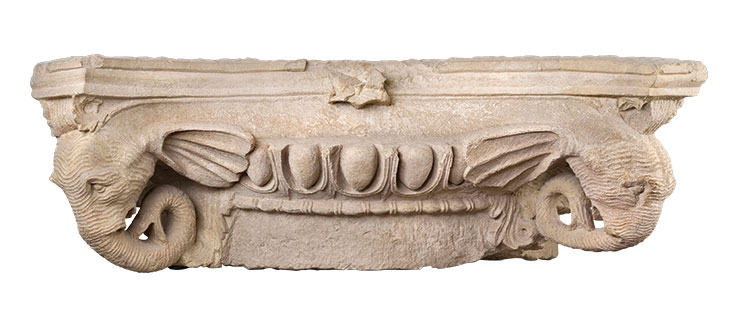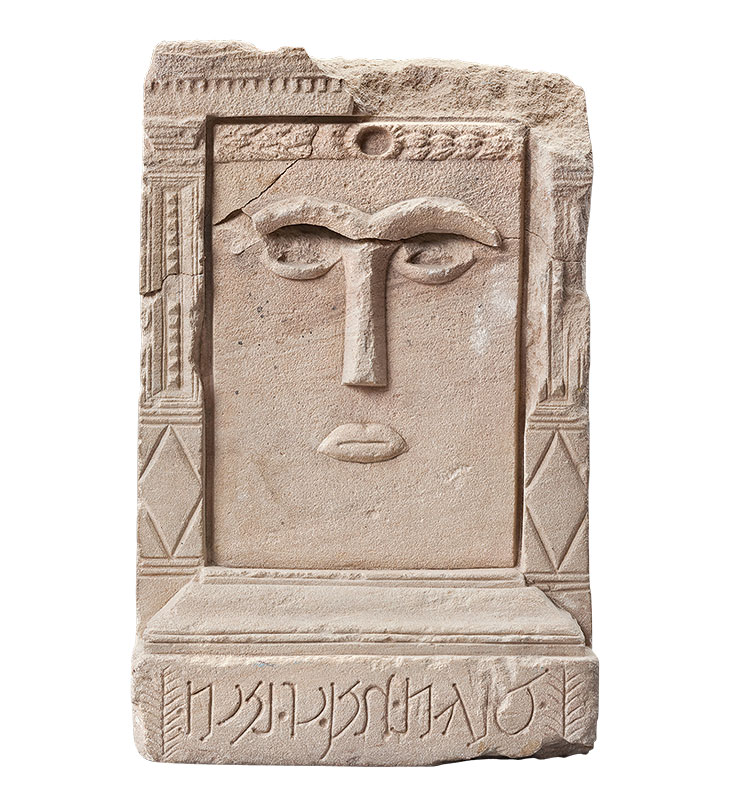Take an Ionic capital, with the familiar volutes on either side, spiralling to a central globe. Or perhaps not so familiar: the volutes have become elephant heads – coiled trunks with prehensile ends shaped to form the interior globes, broad ears fanning out where acanthus sprays should be; open mouths, added-on tusks (now missing), the domed foreheads of the Indian species, and a wonderful deeply furrowed and ridged skin all over. This ornamental capital is not a baroque variation or rococo conceit, but one of hundreds recovered from the so-called Great Temple, at Petra in Jordan. And to see this elephant-head capital in the Tisch Galleries of the Metropolitan Museum of Art is to be reminded that Petra’s famous tombs were part of an urban environment, the capital of the Nabataean kingdom and subsequently a city in the Roman empire.
Elephant capital (1st century BC–1st century AD), Great Temple, Petra. Photo: © Department of Antiquities, Jordan

Petra was endowed with a colonnaded avenue and temples: witness the ronde-bosse panels showing a fleshy, beribbonned head of Dionysos (wearing a fillet across his forehead and ivy and grape leaves in his hair); a goddess with diadem and crinkly v-necked chiton (tunic); and the huge bust of a bearded, Zeus-like deity. The latter, wearing a wreath with a rectangular medallion, is probably the Nabataean god Dushara; the goddess might be his consort, al-‘Uzza. Not far from the temples decorated in this figurative fashion, another shrine received small stelai in which the divinity was represented as a square slab, with stylised features. Yet the divine slab was framed in a rich architectonical scheme of mouldings, dentils, and textured pilasters, part of the same visual world as the elephant-head capitals and the divine busts of the other temples. The slab-deity is wearing a wreath with a central medallion, just like Dushara.
This room of connections and contrasts is the second in ‘The World between Empires’, an exhibition curated by Blair Fowlkes-Childs and Michael Seymour, the authors of the learned yet cautious catalogue (indispensable for understanding historical and spatial contexts for, to give an example, the temples of Petra). With the exception of a few examples from the empire at home (a look at cults of eastern immigrants in Rome, or jewels from a tomb in Italy), the exhibition covers a vast geographic arc, starting in south-western Arabia, jumping to modern Jordan, skipping to Judea and Phoenicia, then proceeding eastwards to Baalbek in the Beqaa valley, the two extraordinary Syrian sites of Palmyra and Dura-Europos, then Hatra in northern Iraq, and finally Mesopotamia (Babylonia, Ctesiphon), stopping on the edges of Iran.
Stele of a goddess (‘Goddess of Hayyan’) (1st–2nd century AD), Petra, Temple of the Winged Lions. Photo: © Department of Antiquities, Jordan

The themes are art, culture, religions and identity in the ancient Middle East, from 100 BC to 250 AD – treated by Fergus Millar in his classic The Roman Near East, 31BC–AD337 (1993). The exhibition begins with a room of extraordinary objects. These include a translucent alabaster goddess from a grave in Babylonia, Greek in proportion and treatment of the naked body form, but with inset rubies for her eyes and her navel; and from Dura-Europos, a bright red Roman shield, reconstructed from fragments found in the debris of a tower destroyed in the siege of the city in 256, and as richly painted as a Roman fresco.
The exhibition’s central notion is that the ancient Near East was a ‘world between empires’ – that of Rome and Parthia, centred on Mesopotamia and Iran – but connected by trade and movement. The Iranian world is represented by strikingly abstracted coins of Parthian rulers, a relief from Hatra, some artefacts from Parthian-era Babylonia, and the final piece in the exhibition: a cameo representing a Sasanian ruler capturing a Roman emperor, which uses a Roman technique to represent the defeat of Rome at the hands of the Iranian dynasty that succeeded the Parthian empire. For all the threat of the cameo, and the graffito of (perhaps) an Iranian heavy cavalryman at the start of the exhibition, the military might and cultural identities of this ‘eastern’ world are underemphasised. The theme of connectivity through trade explains the inclusion of south-western Arabia, a source of incense – and the same juxtapositions of high Hellenistic, local figurative, and abstract modes of representation as seen at Petra. It is less than clear whether these connections create an in-between world, sharing a cultural koine – or whether we are indeed looking at the cultural politics of a ‘Roman Near East’.
Statuette of standing nude goddess (1st century BC–1st century AD), Babylon. Musée du Louvre, Paris. Photo: © RMN-Grand Palais/Art Resource, New York

The detailed evocation of such conjunctions is the greatest success of the exhibition, which gathers material from Jerusalem, Amman, Paris, Berlin – and Cincinnati, whence the decor of a shrine at Khirbet et-Tannur, excavated in 1937, is borrowed for a reunion with pieces now kept in Jordan. The rich ornamentation of a tall altar tower that occupied a central room in the temple combines local deities and zodiac signs, in a region-specific style that yet recalls western provincial art. Similar cultural choices appear in funeral art. A column from Qartaba in Lebanon shows four busts, paired: one man wears Greek dress and has the ‘period face’ of the Roman 150s AD; two women are so laden with ornate hairstyle, headdress and veil that their faces are shrunk to fit within the aedicule; and one man wears a Greek himation (outer garment) with a local priestly hat and leafy bough. At Palmyra, men are shown upright, in the Greek dress that was also the idiom for civic statues, or reclining in the trousers (complete with a dagger strapped to the thigh) and riding jacket of the desert; women wear jewels, veils, and headdresses in the local style, as in the extraordinarily vivid stele of Bat’a sculpted during her lifetime. A memorable image of diversity comes from Dura-Europos, where religious life encompassed reliefs of gods, local and imported (including gods from Palmyra), and Jewish and even Christian frescoes. But diversity intervened even within the same religious sphere: three images of a club-wielding, lion-slaying deity present strikingly different visual choices. Is style a strong bearer of meanings? The world of divine images, such as the stark relief of three Palmyrene gods in armour, suggests the emotional charge and stakes involved in religious choices.
Dura-Europos, during the recent conflict in Syria, has been ravaged by looting, as have sites in Yemen, Hatra, and Palmyra (where the temple of Bel was dynamited by Islamic State). The exhibition constantly reminds us of this, especially in a video installation of three archaeologists – Zainab Bahrani, Michel al-Maqdissi and Michal Gawlikowski – reflecting on the destruction of archaeological heritage and possible prospects. The echo of destruction makes the vividness of the visual world presented here all the more troubling.
‘The World Between Empires: Art and Identity in the Ancient Middle East’ is at the Metropolitan Museum of Art, New York, until 23 June.
From the June 2019 issue of Apollo. Preview and subscribe here.



